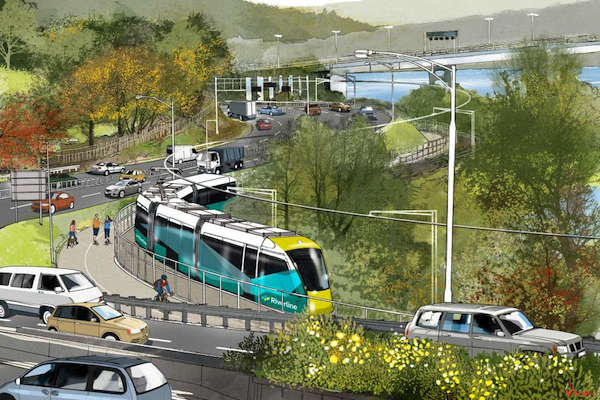Light rail is a planning tool, not simply a mode of transport, says Peter Newman [20 October 2015 | Peter Boyer]
There’s a Climate Tasmania public forum in Hobart this evening that wants participants to think outside the square in building a vision of life in a carbon-constrained world.
With that in mind, I’d like to put up a proposition inspired by Peter Newman, once a Hobart schoolboy and now professor of sustainability at Western Australia’s Curtin University.
There’s a lot of interesting new technology around urban railway, about track and engine design and the energy that makes them work. But what drives Newman, who has won international recognition as a powerful voice for urban rail, has nothing to do with technology.
Most good ideas emerge out of cities, the engine rooms of our economies. As Newman told a Hobart Town Hall meeting ten days ago, he wants our cities to be inspiring and enjoyable places for people to live, work, meet and move around.
Newman’s thinking has crystallised in the multi-year process of developing a light-rail system for his home town, Perth, called Metro Area Express, or MAX.
MAX looked like going ahead until early this year when the WA government announced it might use buses instead. To state transport minister Dean Nalder, a bus network would be “the same project over the same route, providing the customer with exactly the same experience”.
Definitely not so, says Newman. He wrote in The Conversation that new bus services on existing roads increased traffic congestion because governments did nothing to reduce private car use.
He said that cities served exclusively by rubber-wheeled transport tend to sprawl into a pedestrian-unfriendly environment that repels young, creative workers. Developers and governments seeking liveable urban environments, he said, are turning to rail.
He cites US public transport data over 20 years showing tram and light rail systems nearly doubling and heavy rail growing by 52 per cent while urban bus transport contracted by 3 per cent.
Newman supports effective bus networks, but used in tandem with rail to provide feeder services into denser urban hubs, or “activity centres” – a natural outcome of a well-planned rail network.
Newman makes a special plea for a unified approach to planning. At present, town planners seeking vibrant activity centres have no say in crucial transport decisions, while transport planners think just about getting people from A to B when they should be considering good urban development.
With a new prime minister personally interested in improving the state of our cities, state and local administrations across Australia are looking afresh at light rail. That has to happen here too.
Like all cities, Hobart can learn from the Perth experience, especially after a series of studies of Hobart light rail starting in Nick McKim’s term as sustainable transport minister in 2010.
A 2011 report advised against seeking federal funding for a service on the existing Claremont-Hobart railway line, while a 2012 review concluded that a shorter Glenorchy-Hobart service with just one intermediate station would be better. The result has been… no result.
While rail commuting time has been estimated to be less than half the Brooker Highway commute, in Newman’s judgment the more crucial point missed by the studies is that light rail is an urban development tool that can’t be considered in isolation from long-term town planning.
The focus of light rail, says Newman, should be what happens around rail stations fed by buses. The funding load can be spread by tapping into private finance attracted by land and other incentives to develop business centres around the rail hubs.
Given the demonstrated value of light rail in shaping dynamic, creative cities in many countries, allowing existing tracks to fall into disuse should never be an option.
The Hodgman government could start by treating Tasmania’s rail system not as a liability but an opportunity. Its first priority should be to look afresh at the case for a light rail service for Hobart’s northern suburbs with a view to securing federal funding.
The Climate Tasmania forum invites us to free ourselves from the status quo and consider these sorts of questions about our long-term future. It’s on tonight from 5.30 at the IMAS building on Princes Wharf, Hobart.

